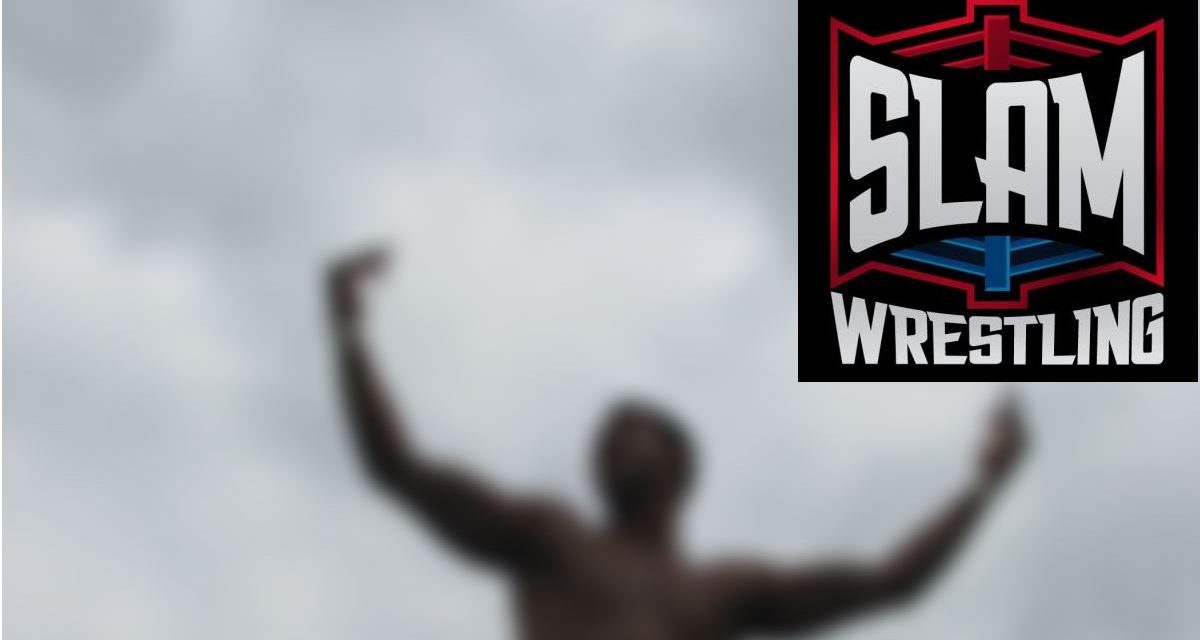Steve DiSalvo never intended to be a professional wrestler. And now that his career is happily in the past, he can chuckle at many of the situations he found himself in, and isn’t shy about his dislike for the business.
Though he never had more than a cup of coffee in the World Wrestling Federation — a couple of tryouts as Sadistic Steve — DiSalvo owes his wrestling career to Vince McMahon. DiSalvo was heavily into powerlifting in the mid-’80s, competing in the national and world championships. He met McMahon, who asked if DiSalvo had ever considered a career in professional wrestling.
“I went, ‘Who wants to do that phony shit?'” recalled DiSalvo for SLAM! Wrestling. “One thing led to another, I got a break up into Calgary. So I went up there. I guess the rest is, in my own little world, history.”
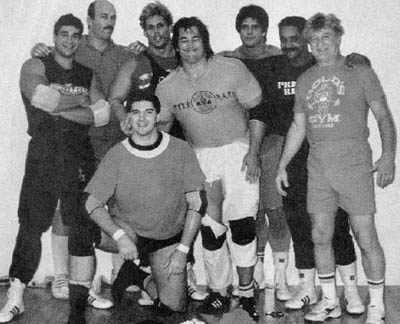
California Training: Left to right, Mark Miller, Dave Sheldon, Bill Anderson (kneeling), Steve Borden, Steve DiSalvo, Jim Hellwig, Garland Donoho and Red Bastien.
The 6-foot-2, 300-pound DiSalvo is getting ahead of himself a little bit. While most of his “polishing” as a professional wrestler came at the hands of Bruce and Ross Hart in the infamous Hart Dungeon in Calgary, his initial training came under Red Bastien and Billy Anderson in California. Perhaps you have even heard of a few of the other students from that session: Sting (Steve Borden), Ultimate Warrior (Jim Hellwig), Angel of Death (Dave Sheldon), and the lesser known Mark Miller and Garland Donoho. Four of them — Borden, Hellwig, Miller and Donoho — would be promoted briefly as Powerteam U.S.A.
Certainly an elite class. But DiSalvo scoffs at the notion that anyone knew what stars they would be — it’s all about the promoter choosing who he wants, he said. According to DiSalvo, the shadiness started right at the beginning. “Red never got paid by them. I think that Dave and I were the only ones that ever paid Red Bastien, the trainer,” he said, adding that “Red didn’t really train me.” In the ring demonstrating a lot of the bumps was Bill Anderson, who recalled DiSalvo as being “very respectful” and “tough as nails.”
In early 1986, DiSalvo went east to Montreal — and briefly the Maritimes — where he was dubbed “Sadistic” Steve Strong, and given Eddie “The Brain” Creatchman and “Pretty Boy” Floyd Creatchman as his managers. He was given the chance for interview time, and really took off in popularity, exuding confidence and showing off a body comparable to wrestling’s top dog at the time, Hulk Hogan. “Sadistic” Steve was the talk of schoolyards, where fans thought he was destined for the big time. His growing popularity eventually prompted a babyface turn in Montreal.
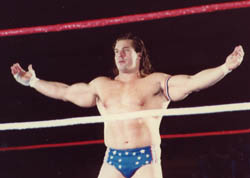
“Strangler” Steve DiSalvo in 1988 at a show in Toronto. Photo by Greg Oliver
In short, DiSalvo, still has a following in Montreal, with those who remember the last days of International Wrestling. “That was fun. It’s like anything, you like to get your ego pumped. … It was a good time. The cities I liked, I stayed in. I only stayed in the three — Puerto Rico, Montreal — I liked Toronto, too, but we were never there much.”
DiSalvo didn’t really fit in with his wrestling colleagues, preferring the gym and his hotel room to the bar scene. Even in regards to steroids, he was different. “I took them. I was probably the only one that took them under a doctor’s supervision,” he admitted. “I had been training 10 years, eight years, before I ever took a steroid. I was naturally 280, 285, just from lifting and training, running and all that. So before I ever took a steroid, I had enough size.”
He had never wanted to be a pro wrestler and didn’t see it as a long-term plan.
“I didn’t want to make it a career forever,” he said bluntly. “Unlike 99 percent of the guys, I kept to myself, went to train, and go eat, and that’s it. The last thing I was was a partier. I think I maybe went to one bar all the time I was wrestling.”
Evidently, the promoters saw it somewhat the same way. Montreal’s Gino Brito made DiSalvo a star. “Honestly, even when I had him, the guy was lost. Mentally lost. I really tried to help him out because he had everything going for him,” Brito said. “He had the look. He thought, first of all, that he knew everything. I tried one time in Hull. I said, ‘Look, you and Ricky Martel, you can sell this place out. Go on TV.’ But it just didn’t work out. I don’t know what happened.”
Bill Anderson, who worked many WWF TV tapings as enhancement talent, was at one of DiSalvo’s WWF tryouts, and said that his trainee marched to his own drummer. “When he got a tryout for WWF years ago, here in Phoenix at the Coliseum — Steve was the kind of guy who lived his life the way he wanted to live it, never changed anything. He showed up at these tapings in some sweat clothes, I’ll never forget it! Big holes in the pants and everything. But that’s what he was comfortable in. He didn’t believe in changing for anybody. Remarkable guy.”
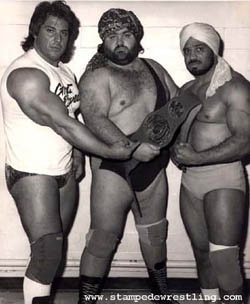
Karachi Vice: “Strangler” Steve DiSalvo, Makhan Singh and The Great Gama
Back in Calgary, “Strangler” Steve DiSalvo shot to the top of the dying Stampede Wrestling promotion. Like Montreal, he was a heel initially, a part of Makhan Singh’s Karachi Vice, before fans turned him babyface. DiSalvo remembers the mouth of Makhan Singh, Mike Shaw, the most. “Talk about a good time, just listening to him, just with his wit. He didn’t care. He was quite the classic.”
Again, like Montreal, fans of that era recall DiSalvo fondly. Stuart Kemp, who would later wrestle as Bulldog Bob Brown Jr., was a fan in the ’80s, and talked about DiSalvo in a 2004 Ring Around the Northwest newsletter. “DiSalvo was by far the best of the muscle guys. He wasn’t so immobile and he had a great feud with Jason The Terrible (Karl Moffat).”
Stints in the AWA and WCW were not as memorable, or long.
In Minneapolis for Verne Gagne, DiSalvo figures he was there “about three weeks, until he didn’t pay.”
It’s a good story. “He had me as Wahoo McDaniel’s protege. To make a long story short, he forgot I was coming in, flew me in, and I go to the arena for TV. He goes, ‘Who are you?’ I’m going, ‘Okay, this is good.’ I told him. ‘Oh, you’re the Indian.’ ‘Indian, what the hell are you talking about?’ … ‘Do you have an Indian headdress and all that?’ ‘No.’ He said, ‘Wahoo, give him your headdress.’ That was the making of Billy Jack Strong. Another alias.”
In WCW, DiSalvo was The Minotaur. Forgettable? Absolutely.
“Ole Anderson brought me in and he got fired, the day that I got there, maybe three days before. I said, ‘Should I come down?’ He said, ‘Yeah, yeah. They’ll take care of you, Ric Flair’ — I forget who else was there — ‘but still go on down and get a run out of it, and see what they can do.’
“I got down there, and they didn’t have a damn clue. At that point, mentally I was out of it. I just didn’t want to pursue it as much. Then that was it.”
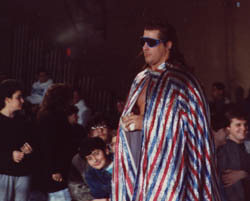
“Strangler” Steve DiSalvo in 1988 at a show in Toronto. Photo by Greg Oliver
It’s Puerto Rico that holds a lot of memories for DiSalvo, for a variety of reasons. “They paid me. I actually liked Puerto Rico,” he deadpanned. “They actually did treat me really well.”
He was given a huge win over Carlos Colon for the WWC Universal title, though only a few knew that Colon was headed off for shoulder surgery. “They built me up. Was I good? No, I wasn’t a good wrestler. I couldn’t do crap. But I could do the show and that was it, the more important thing. People loved to hate me, and gradually I got over,” DiSalvo explained, recalling that his win came a day before he escaped the island, just a day ahead of Hurricane Hugo hitting land. Because nobody really ever beat Colon — even constant foe Abdullah the Butcher — DiSalvo was propelled to the upper echelon.
The memory of DiSalvo’s upset stuck around enough that he was lured out of retirement in April 2001 for Victor Quiones’s IWA in Puerto Rico. “I figured, ‘I want to go down and Puerto Rico,” said DiSalvo, recalling the conversation with TNT:
“What kind of shape are you in?”
“Christ, I haven’t even been to the gym. I weight train. I’m a fat slob, what do you want? I train everyday, cardio and all that. Wrestling-wise, I haven’t thrown a fake punch in years.”
The tour, dubbed Dia Del Juicio Final (Final Judgment Day), was very brief for DiSalvo. Tipping the scales at over 350 pounds, he admitted to being “too fat, too old” to be in the ring.
DiSalvo had been smart with his money during the years, investing in real estate. For the last dozen years or so, he has worked in Minneapolis as a technical recruiter, specializing in IT and engineering. Do clients ask about his wrestling past? “It really hasn’t opened any doors, but people like to hear about it. They go, ‘Oh geez, you were a professional wrestler?’ ‘Yeah, I did that.'”
He has no regrets about a career in professional wrestling and he was able to pass on his athletic genes to his son and daughter, both of who excel in sports. “I met my wife and everything else, and it’s been 19 years that we’ve been together. If I had to do it again, I guess I would. I liked Stu Hart … I made okay money, and the money I did make, I bought real estate, did the right things that I should have.”
Greg Oliver first met Steve DiSalvo in 1987 when he was writing the Canadian Wrestling Report newsletter, and was always a big fan. Requests for a profile on DiSalvo have come in regularly over the years, and he is happily to (finally) deliver.
